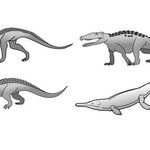Evolution

A recent study describes a new species of vampyropod based on a 328-million-year-old fossil and pushes back the age of the group by nearly 82 million years. And shows that the oldest ancestors of the group of animals that includes octopuses and vampire squids had not eight but 10 arms.
Vampyropods are soft-bodied cephalopods typically characterized by eight arms and an internalized chitinous shell or fin supports. Because they lack hard structures, Vampyropoda are not well represented in the fossil record. The new study is based on a vampyropod fossil from the collections of the Royal…

Was Charles Darwin a one-hit wonder? According to scientists who take a gene’s-eye view of evolution, the 19th-century English naturalist contributed one crucial idea to understanding how species change: natural selection, or “design without a designer”.
However, a book of Darwin’s that is little read by modern evolutionists – The Expression of the Emotions in Man and Animals – turns out to contain valuable lessons for scientists seeking to understand how and why humans do what we do.
Published 150 years ago, the book has long bemused scientific readers because it hardly mentions natural…

Over the course of evolutionary history, Greenlanders have benefited from a genetic variation that offers an incredible advantage; two copies of a gene variant make it so that they absorb sugar differently than other people do.
A new study finds that up to 3 percent of Greenland residents, based on analyzed data from 6,551 adult Greenlanders, have the sucrase-isomaltase variant, and experiments on mice may fill in reasons why those with the variant have lower BMI, weight, fat percentage, cholesterol levels and are generally significantly healthier.
For those that do, more sugar is not less…

The ancient relative to modern humans Australopithecus sediba walked like a human, but climbed like an ape, filling in a gap in the fossil record long posited by biologists, finds a new analysis.
The recovery of new lumbar vertebrae from the lower back of a single individual of the human relative, Australopithecus sediba, and portions of other vertebrae of the same female from Malapa, South Africa, together with previously discovered vertebrae, form one of the most complete lower backs ever discovered in the early hominid record and give insight into how this ancient human relative walked and…

Microfossils found in rock samples retrieved in Australia more than 60 years ago (DOI 10.1126/science.abj2927) fill an approximately 25-million-year gap in knowledge by reconciling the molecular clock - or pace of evolution - with the fossil spore record - the physical evidence of early plant life gathered by scientists over the years.
This reconciliation supports an evolutionary-developmental model connecting plant origins to freshwater green algae, or charophyte algae. The “evo-devo” model posits a more nuanced understanding of plant evolution over time, from simple cell division to initial…

The remains of 36 bubonic plague victims from a 16th century mass grave in Germany provide evidence that evolutionary adaptive processes, driven by the disease, may have conferred immunity on later generations of people from the region.
The researchers collected DNA samples from the inner ear bones of individuals in a mass grave in the southern German city of Ellwangen which experienced bubonic plague outbreaks in the 16th and 17th centuries. Then they took DNA samples from 50 current residents of the town. They compared their frequency spectra - the distribution of gene variants in a given…

Though modern humans and our closest evolutionary relatives, the great apes, shared a common ancestor millions of years ago, most similarities stop there. We live on the ground, walk on two legs and have much larger brains.
That doesn't mean the larger brains evolved first.
The first populations of the genus Homo emerged in Africa about 2.5 million years ago and though they already walked upright, their brains were only about half the size of today's humans. These earliest Homo populations in Africa had primitive ape-like brains - just like their extinct ancestors, the…

A lot has changed since the age of dinosaurs hundreds of millions of years ago. Humans didn't exist and dinosaurs are gone. Yet crocodiles are still here and, unlike humans, have not evolved much by comparison.They even look similar to ones from the Jurassic period some 200 million years ago.
A new study find that it's due to a 'stop-start' pattern of evolution, governed by environmental change. This pattern of evolution known as "punctuated equilibrium" is generally slow, but occasionally means faster evolution because the environment has changed. This new research suggests…

An American might ask if the mayonnaise is spicy while an Asian will warn them they only think they want the hot sauce on Asian food. A woman is more likely to be better at detecting bitter tastes than men.
The difference is not cultural, that some people are timid when it comes to food, is it anatomical. A new study found that Danes aren't quite as good as Chinese at discerning bitter tastes - and the reason is biology. So if you are more sensitive to the bitter taste found in broccoli, Brussels sprouts and dark chocolate, you now know why.
In the study, 152 study participants were all…

A new paper finds that mass extinction of land-dwelling animals - amphibians, reptiles, mammals, and birds- occur in a cycle of about 27 million years.
A pattern in nature or just coincidence?
Probably coincidence, since 27 million years give or take is a fantastic range of time but journalists and professional doomsday prophets are making something of it the way they do Mayan calendars and Biblical numerology. When it comes to real concepts of time, 66 million, 26 million, and 27.5 million don't have much in common.
Yet the paper does link them as non-random events, using the bane of…